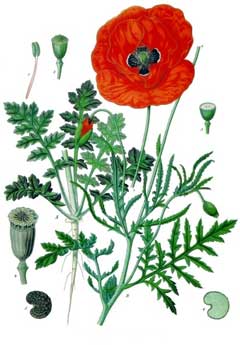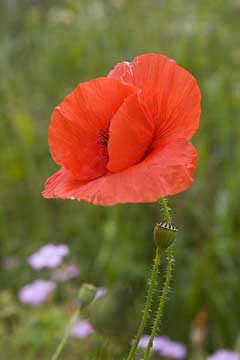 |
|
http://commons.wikimedia.org/wiki/File:Koeh-101.jpg |
 |
| http://commons.wikimedia.org/wiki/User:MichaelMaggs |
Translate this page:
Summary
Bloom Color: Red. Main Bloom Time: Early summer, Late spring. Form: Upright or erect.
Physical Characteristics

 Papaver_rhoeas is a ANNUAL growing to 0.6 m (2ft) by 0.2 m (0ft 8in) at a fast rate.
Papaver_rhoeas is a ANNUAL growing to 0.6 m (2ft) by 0.2 m (0ft 8in) at a fast rate.
See above for USDA hardiness. It is hardy to UK zone 5 and is not frost tender. It is in flower from June to August, and the seeds ripen from August to September. The species is hermaphrodite (has both male and female organs) and is pollinated by Bees, flies, beetles. The plant is self-fertile.
It is noted for attracting wildlife.
Suitable for: light (sandy), medium (loamy) and heavy (clay) soils and prefers well-drained soil. Suitable pH: mildly acid, neutral and basic (mildly alkaline) soils. It cannot grow in the shade. It prefers moist soil.
UK Hardiness Map
US Hardiness Map
Synonyms
Plant Habitats
Edible Uses
Seed - raw or cooked. Much used as a flavouring in cakes, bread, fruit salads etc[4, 5, 21, 183], it imparts a very nice nutty flavour[K]. The seeds are rather small, but they are contained in fairly large seed pods and so are easy to harvest. The seeds are perfectly safe to eat, containing none of the alkaloids associated with other parts of the plant[238]. Leaves - raw or cooked[7, 52]. Used like spinach or as a flavouring in soups and salads[132, 183]. The leaves should not be used after the flower buds have formed[7]. Some caution is advised, see the notes above on toxicity. An edible oil is obtained from the seed[2, 4]. Said to be an excellent substitute for olive oil[4, 183], it can be used in salad dressings or for cooking[2]. A syrup can be prepared from the scarlet flower petals, it is used in soups, gruels etc[4, 183]. A red dye from the petals is used as a food flavouring, especially in wine[183].
References More on Edible Uses
Medicinal Uses
Plants For A Future can not take any responsibility for any adverse effects from the use of plants. Always seek advice from a professional before using a plant medicinally.
The flowers of corn poppy have a long history of medicinal usage, especially for ailments in the elderly and children[244, 254]. Chiefly employed as a mild pain reliever and as a treatment for irritable coughs, it also helps to reduce nervous over-activity[254]. Unlike the related opium poppy (P. somniferum) it is non-addictive[244]. However, the plant does contain alkaloids, which are still under investigation, and so should only be used under the supervision of a qualified herbalist[244]. The flowers and petals are anodyne, emollient, emmenagogue, expectorant, hypnotic, slightly narcotic and sedative[4, 7, 9, 13, 46, 53]. An infusion is taken internally in the treatment of bronchial complaints and coughs, insomnia, poor digestion, nervous digestive disorders and minor painful conditions[9, 238]. The flowers are also used in the treatment of jaundice[218]. The petals are harvested as the flowers open and are dried for later use[238]. They should be collected on a dry day and can be dried or made into a syrup[4]. The latex in the seedpods is narcotic and slightly sedative[240]. It can be used in very small quantities, and under expert supervision, as a sleep-inducing drug[7]. The leaves and seeds are tonic[240]. They are useful in the treatment of low fevers[240]. The plant has anticancer properties[218].
References More on Medicinal Uses
The Bookshop: Edible Plant Books
Our Latest books on Perennial Plants For Food Forests and Permaculture Gardens in paperback or digital formats.

Edible Tropical Plants
Food Forest Plants for Hotter Conditions: 250+ Plants For Tropical Food Forests & Permaculture Gardens.
More

Edible Temperate Plants
Plants for Your Food Forest: 500 Plants for Temperate Food Forests & Permaculture Gardens.
More

More Books
PFAF have eight books available in paperback and digital formats. Browse the shop for more information.
Shop Now
Other Uses
A red dye is obtained from the flowers[7, 46, 61], though it is very fugitive[4]. A syrup made from the petals has been used as a colouring matter for old inks[4, 13, 89]. The red petals are used to add colour to pot-pourri[238].
Special Uses
References More on Other Uses
Cultivation details
Landscape Uses:Border, Massing, Seashore, Specimen. Prefers a well-drained sandy loam in a sunny position[1, 200]. Does not do well on wet clay soils but succeeds in most other soils[115]. Plants usually self-sow freely when growing in suitable conditions so long as the soil surface is disturbed[238]. There are several named varieties selected for their ornamental value[200]. A polymorphic species, varying in leaf shape and flower colour[17]. When growing in cereal fields, poppies decrease the yields of nearby cereal plants[18, 20]. Members of this genus are rarely if ever troubled by browsing deer or rabbits[233]. Special Features:
Attractive foliage, Not North American native, Naturalizing, All or parts of this plant are poisonous, Suitable for cut flowers, Suitable for dried flowers.
References Carbon Farming Information and Carbon Sequestration Information
Temperature Converter
Type a value in the Celsius field to convert the value to Fahrenheit:
Fahrenheit:
The PFAF Bookshop
Plants For A Future have a number of books available in paperback and digital form. Book titles include Edible Plants, Edible Perennials, Edible Trees,Edible Shrubs, Woodland Gardening, and Temperate Food Forest Plants. Our new book is Food Forest Plants For Hotter Conditions (Tropical and Sub-Tropical).
Shop Now
Plant Propagation
Seed - sow spring or autumn in situ[200].
Other Names
If available other names are mentioned here
Native Range
TEMPERATE ASIA: Afghanistan, Cyprus, Egypt (Sinai), Iran, Iraq, Israel, Jordan, Lebanon, Syria, Turkey, Russian Federation-Ciscaucasia (Ciscaucasia), Armenia, Azerbaijan, Georgia, Russian Federation (Dagestan) TROPICAL ASIA: Pakistan EUROPE: Denmark, United Kingdom, Ireland, Norway (southeast), Sweden (south), Austria, Belgium, Switzerland, Czech Republic, Germany, Hungary, Netherlands, Poland, Slovakia, Russian Federation-European part (European part (west)), Belarus, Lithuania, Latvia, Moldova, Ukraine (incl. Krym), Albania, Bulgaria, Bosnia and Herzegovina, Greece (incl. Crete), Croatia, Italy (incl. Sardinia, Sicily), North Macedonia, Montenegro, Romania, Serbia, Slovenia, Spain (incl. Baleares), France (incl. Corsica), Portugal AFRICA: Spain (Canarias), Portugal (Madeira Islands), Algeria (north), Egypt, Libya (north), Morocco, Tunisia
Weed Potential
Right plant wrong place. We are currently updating this section.
Please note that a plant may be invasive in one area but may not in your area so it’s worth checking.
Conservation Status
IUCN Red List of Threatened Plants Status :

Growth: S = slow M = medium F = fast. Soil: L = light (sandy) M = medium H = heavy (clay). pH: A = acid N = neutral B = basic (alkaline). Shade: F = full shade S = semi-shade N = no shade. Moisture: D = dry M = Moist We = wet Wa = water.
Expert comment
Author
L.
Botanical References
17200
Links / References
For a list of references used on this page please go here
Readers comment